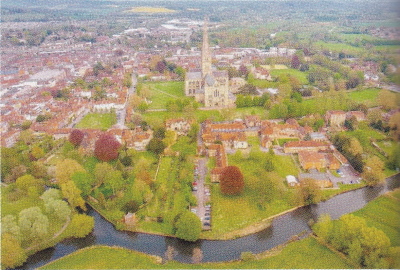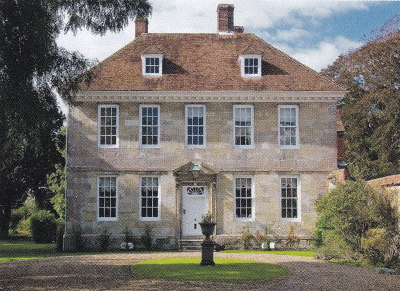TrustNews Dec 21
Members' visits 2021
Despite Covid restrictions we were able to organise two members' outings this year.
Salisbury Close
On a warm, sunny day in September, 25 members and their guests met on Choristers' Green in Salisbury Close for the first Members' Outing since the pandemic. We started with a walking tour of the Close itself led by two of Salisbury's Blue Badge Guides, who were a fount of knowledge about every single building. At 80 acres, Salisbury is the largest cathedral close in the country and was laid out in the 13th century for the Canons of the new cathedral to build "fair houses of stone".
div class="center">

Aerial photo of Salisbury Cathedral and its Close (Photo Nash)
Most of the houses have been altered, rebuilt or repurposed many times. The Grade I listed King's House for example, started life as the Sherborne Canonry - where the Abbots of Sherborne stayed when in town on ecclesiastical andpolitical business. After the Reformation it was renamed following visits by James l. Later it housed Godolphin Girls' School, then became part of a teacher training college. In 1979 it was acquired for the Salisbury Museum and now houses their world famous collections of Neolithic and Stonehenge related material amongst much else.
We saw plaques to William Golding, Salisbury's Nobel laureate, who wrote "The Lord of the Flies" while an English Master at Bishop Wordsworth's School, and was inspired by the view from his study window to write "The Spire", his novel about the building of Salisbury Cathedral.
On the narrow lane leading to St Ann's Gate is a plaque commemorating the three Protestant martyrs burnt at the stake for refusing to acknowledge the pope's authority during the reign of Queen Mary.
Above St Ann's Gate is a small room which was a chapel until the reformation and later became a music room belonging to Malmesbury House, where Handel is said to have given his first English Concert.

Arundells, Salisbury (Photo Arundells)
In the afternoon we were given a private guided tour of Arundells. It too was a school at one stage and fell into disrepair before it was restored and then purchased by Sir Edward Heath in 1985. He spent the rest of his life there hosting many famous visitors and grand parties. It is now maintained by a trust and is still furnished with all of his possessions which clearly reflect his political life and his passions for music and sailing. The day ended with a stroll through the beautiful gardens that run down to the river Avon.
The Edward Barnsley Workshop and All Saints Church, Steep
On 10th November, 12 members of the Trust converged upon the Workshop at Steep and were greeted by James Ryan, designer, craftsman and manager of the workshop. He is its inspiration. We were shown the store of maturing timber of varying lengths and thicknesses. It is stored for five years under cover and we learned of the origins of the different pieces, some all the way from the Scottish Borders and Highlands.

Furniture at the Workshop (Photo City of Winchester Trust)
We then moved into the machine shop to see an array of sophisticated machines, many computer controlled and housed in an old, much modernised building. From there we entered the main working area and saw several craftspeople at work, all showing great skill and patience. Our final stop was the showroom to see a number of pieces, large and small, and all quite dazzling in quality and style. The Workshop is a haven of skills and style.
Finally, we visited the nearby All Saints Church in Steep, where we were given a history of the church and guidance on its most interesting features by a member of the church. Of these, attention focused on the window by Laurence Whistler in memory of Edward Thomas, the First World War poet, who was killed in action at the Battle of Arras in 1917.
Next year we are planning a number of visits, including the rescheduling of Chris Maxse's tour of the painted churches of Hampshire and Sussex and a visit to Southwick to see the village, church and Southwick Park, D-Day HQ
